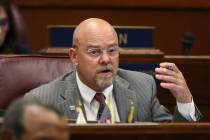When the needs are greater than the means, use gimmicks
Although neither man would probably care to admit it, Republican Nevada Gov. Brian Sandoval and Democratic President Barack Obama have something in common: They both propose to spend more money than their respective governments will take in via taxes.
Although Sandoval pledged not to raise taxes — a promise he’s kept — and Obama made no such promise, their budgets at a fundamental level recognize a harsh reality: There are more needs in Nevada, and in America, than there is money to meet them.
Oh, and both are catching hell from the loyal (or loyal-ish) opposition.
Democratic state Sen. Steven Horsford, charts and graphs at the ready, continued to attack Sandoval’s $5.8 billion budget last week for what he called “trickery” — the use of local property tax funds, school district bond reserve money and borrowing against future taxes. Sandoval responded by asking, once more, if the Democrats disliked his plan so much, where was their alternative?
Lost amid the low-intensity conflict was the fact both Sandoval and Nevada Democrats — whether they are willing to admit it or not — agree fundamentally on one very important thing: Nevada can’t live with a real balanced budget.
Consider: The Economic Forum put estimated general fund revenue to the state over the next two years at $5.3 billion. But Sandoval’s budget is $5.8 billion, and there’s additional spending that’s not counted against the general fund beyond even that. So whether the governor admits it or not, he’s acknowledged he is spending more than he has.
For the record, Sandoval does not admit that.
“No, I don’t think so, I wouldn’t phrase it as that. We wanted to make existing tax dollars work harder,” Sandoval said in an interview in his expansive office in the Capitol.
Earlier in the week, the governor’s deputy chief of staff, Dale Erquiaga, had frankly said the so-called “gimmicks” were necessary. “The cuts would have been too deep” otherwise, Erquiaga said. But neither did Sandoval want to increase taxes. He promised the electorate he would not, and borrowing against future tax receipts or pilfering from counties and school districts apparently doesn’t count.
Sandoval says he and his staff worked meticulously to find the funds to make the cuts as bearable as possible. “We were concerned about that,” he said. “That’s why this wasn’t just a blind acceptance of the former budget that was presented (by former Gov. Jim Gibbons). This was also an effort that we methodically went through all the budget accounts and where the money was coming in and what was available to try to help as many folks as we could.
“None of these decisions are easy,” he added. “I understand there are consequences to that.”
It is those consequences — to schoolchildren, college students, autistic kids, seniors and others — the Democrats have focused on almost since the governor’s budget rolled off the printing presses. According to Horsford, the consequences could include a tax increase, if the school districts cannot afford debt payments on construction bonds because those funds have been diverted for day-to-day operations. “The governor is proposing a property tax increase on the Clark County voters,” Horsford said in an interview in his office. “It does not pencil.”
Sandoval’s question remains, however: If the Democrats don’t like Sandoval’s method for spending more, what’s their solution? Thus far, no Democratic plan has emerged.
But on one core issue, the no-new-taxes Sandoval and the crypto-tax Democrats (not to mention President Obama) are in full agreement: A hold-the-line, live-within-your means budget is simply unacceptable. Now, it’s simply a matter of which plan to augment the budget will win the day.
Steve Sebelius is a Review-Journal political columnist and author of the blog SlashPolitics.com. Follow him on Twitter at www.twitter.com/SteveSebelius, or reach him at (702) 387-5276 or at ssebelius@ reviewjournal.com.












